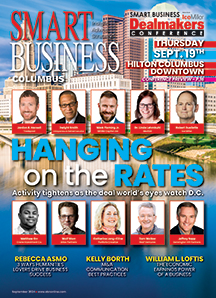This month’s Uniquely Akron/Canton highlights the MAPS Air Museum, which houses and restores military aircraft. The museum’s focus, however, isn’t on the conflicts. It’s trying to illustrate the development of aviation engineering and its impact on man. The conflicts, however, are key points in time that accelerated the development of the science of aviation.
Considering this, I was struck by conflict’s role in a workplace. An external challenge, say from an encroaching competitor, can be a valuable motivator that drives innovation and forces executives and staff to find a new way to win or maintain business.
Meeting the threat
A close example in this month’s edition is from columnist Damon Hacker, president and CEO of the digital forensic company Vestige Digital Investigations. He makes the point that every company, regardless of size or industry, is a target for cybercrime. Combatting digital thieves requires that the entire organization be engaged to meet the threat.
“Organizations must not only recognize but embrace the idea that cybersecurity is not IT’s problem, it is everyone’s problem,” Hacker writes.
Taking the idea further, while cybercrime has damaging consequences for companies, it’s spawned many companies that fight cybercrime and elevated the importance of employees who can help an organization tighten its digital security. Increased demand for those skilled enough to fill the technology gap can be traced to the creation of the Software Craftsmanship Guild, the focus of this month’s feature.
The school, which teaches software development in an intensive 12-week course, is boasting a 95 percent placement rate for its students, most of whom are offered jobs prior to graduation.
As Anthony Hughes, president of the school puts it, “We don’t have fraternities and sororities. We don’t have a sports team. We have classrooms, instructors and very hungry learners, and we have a network of 70 employers who are literally ready to hire these people right away (because) they have the skills that the employers want.”
The shifting mentality
Conflict can also have a negative impact. Employees can conflict with one another, with management and with the rules imposed by the company that reward and discourage certain behaviors.
This month, columnist Daniel Flowers, president and CEO of the Akron-Canton Regional Foodbank, writes about the need for employers to embrace an employee-centered approach to work and culture. This philosophy may help as a talent attraction and retention strategy, a subject that is getting more attention as the market thaws, hiring picks up and employees have more job options from which to choose.
As Flowers writes, “We ask a lot from our people. Business has to move with the way our societies and minds are forming around new ways of being in community. It’s the right thing to do and this new millennial generation of workers won’t stick around and wait for you to clue in to the shifting mentality.”
Conflict is a great motivator, triggering a fight or flight action from whomever it reaches. If channeled effectively, conflict may drive competition. When unchecked, however, its fallout may be devastating.

